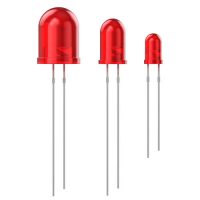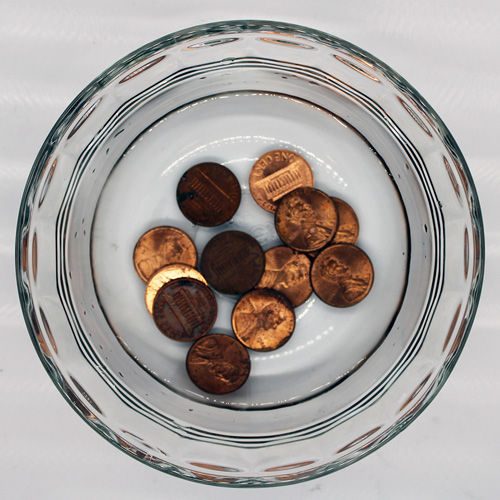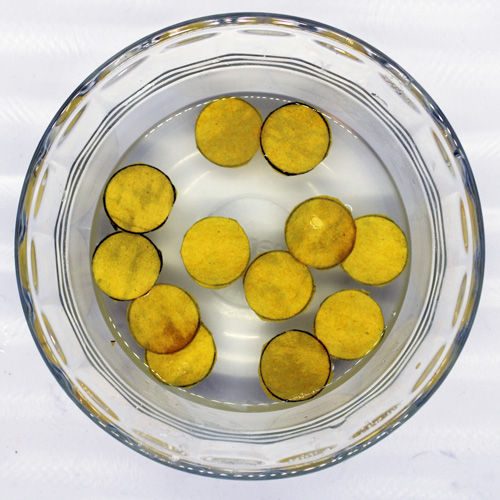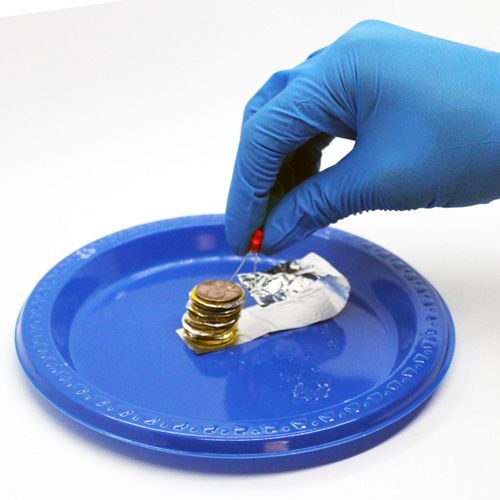By Sherri C. Rukes
Introduction
In this activity, you can build a simple battery with enough power to light a small red lightbulb (or a buzzer/fan)! You’ll feel the joy of building your own battery, just like Alessandro Volta did when he discovered batteries in 1780!
Question to Investigate
How can you light a bulb (or sound a buzzer) with pennies and foil?
Safety Suggestions
- Safety goggles required
- Thoroughly wash hands after this activity
- Use forceps (tweezer) to remove items from vinegar solution
- Ask your adult partner to cut the aluminum strip
Materials
- 12 pennies
- Aluminum foil
- 12 zinc washers, ¾” wide (about 2 cm) (optional)
- Construction paper, 6” x 12” inch (about 15 x 30 cm), any color
- Small red LED bulb (search online for “5 mm red LED bulbs”)
- Optional buzzer in place of the light (search online for “hobby buzzer/motor” or “buzzer for circuit”)
- 2 Tbsp (30 mL) of household vinegar, colorless
- 2 tsp table salt
- 5 mL (teaspoon) measure
- 15 mL (tablespoon) measure
- Plate, lid, or small tray
- Tap water
- Small bowl
- Scissors
- Spoon
- Forceps (tweezers)
Notes
- Zinc washers work best. But aluminum foil also works fine (like in the pictures).
- For making additional cells, you will need extra pennies, foil, and construction paper. This is especially the case for using a buzzer or fan instead of a small red lightbulb.
- Have an adult tear a strip aluminum foil about 4 inches (or 10 cm) wide.



Procedure
I. Prepare the night before
- Pour 2 Tbsp of vinegar into a small bowl. Add the pennies, cover them, and let soak overnight to clean them.
- In the morning, remove the pennies from the vinegar using forceps and rinse them with water.
- Lay them on a paper towel to dry and rinse the bowl.
II. Prepare the pieces of your battery
- Ask your adult partner to cut one rectangular strip of aluminum foil that is ¾” (2 cm) wide and 6” (15 cm) long.
- Use a pencil to trace a penny on the construction paper 12 times.
- Use scissors to cut out 12 disks from the construction paper. If you’re using foil instead of zinc washers, you can layer the paper over the foil and cut out both together.
- Add 2 Tbsp room-temperature water and 2 Tbsp of salt to the bowl. Gently stir with a spoon until the salt dissolves.
- Place the construction paper disks in the saltwater to soak for about 1 minute. Then, remove and place them on a tray or plate.
III. Build your battery
- Place the strip of aluminum foil on the plate so that one end is at the center of the plate.
- Place one moist construction paper disk on top of the foil. Place a penny over it. This stack of foil-paper-penny is called one cell.
- Stack more foil-paper-penny cells on top of the first one. The setup must end with a penny resting on the very top. Your battery will have 12 cells (see pictures below).
IV. Test your battery
- The LED bulb has one long and one short “leg.” Position the long leg touching the penny on top of the stack. Place the shorter leg touches the loose end of the foil. You can bend the legs of the LED bulb to do this. Does the LED light up? If not, try the “Troubleshooting tips” box below.
- Can you light up the bulb using fewer cells? Try it! What is the fewest number of cells you need to use to light up your bulb? What would you do to make the bulb glow brighter?
Troubleshooting tips:
- Squeeze out excess liquid from the battery stack and let it rest for about an hour or two.
- Double check that all foil-paper-penny cells are correctly ordered in your battery.
- Do not squeeze the cells together when trying to light the bulb. It works better if they are a little loose.

How does it work?
Your completed battery works because electrons flow between the anode (aluminum foil/zinc washer) and cathode (penny) through the bulb (it lights up). All atoms contain electrons. Some atoms (like the copper in the penny here) “hold onto” their electrons more tightly than some other atoms (like aluminum/zinc in the foil/washer). When the LED bulb is connected to the setup, it allows the loosely-held electrons from the aluminum/zinc anode to flow through the bulb to the penny cathode.
Two different chemical reactions take place to convert chemical energy to electrical energy or electricity. The type of chemical reaction happening at the penny is called reduction (when electrons are gained). The one happening at the zinc washer is called oxidation (which is the name for the loss of electrons). One cannot happen without the other. That’s how batteries work!
Sherri C. Rukes is a chemistry teacher at Libertyville High School in Libertyville, Illinois.

